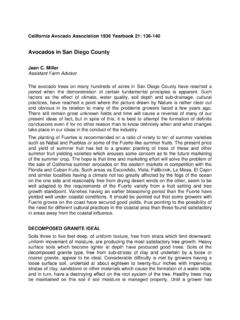Transcription of RAND WATER Plant fruit trees - waterwise.co.za
1 Randwater 7/10/06 11:11 AM Page 34. Conserving WATER , Conserving the Enrironment rand WATER . Grow fruit to sell Plant fruit trees Grow your own fruit trees for a healthy harvest for your family, or to sell for extra money D eciduous trees are a good WATER Wise choice for summer rainfall gardens, as they don't need much WATER during the dry winter, when they are dormant. It is easy to grow a peach, apricot, pear or plum tree just make sure that you choose self-pollinating plants or Plant the required pollinator as well. keeping the soil moist for the roots. Keep the mulch 10cm away from How to grow fruit trees the tree trunk. Use grass, bark chips, The following steps will give your tree pebbles or leaves and keep replacing. a good start: In the first two years, give each fruit tree Choose a sunny place. 1 bucket of manure with 2 handfuls of Make a hole 1m x 1m x 1m.
2 Keep superphosphate fertiliser in August. In the fertile topsoil in a separate heap. the next two years, give each fruit tree Mix 2 parts topsoil with 1 part compost 2 buckets of manure and 4 handfuls and a cup of superphosphate and of superphosphate. Thereafter, give return to the hole with lots of compost. 3 buckets of manure and 8 handfuls To make deep watering easy, insert a of superphosphate per tree . Manure pipe in the hole with one end sticking should always be well composted out before you fill up the hole. before using. Cut open the planting bag, remove the tree and Plant at the same level as Choosing your fruit it was in the bag. The stem must not be Apricots. Its attractive shape makes buried any deeper than it already is. the apricot a useful shade tree . The fruit Make a large basin around the tree can be eaten fresh, bottled, made into to hold WATER .
3 For the first two years, jam or dried. WATER in late winter and WATER once a week. Then slow down early spring as all apricots ripen in to twice, and then once a week. early summer. They are self-pollinating, Put a layer of mulch 10cm deep so a single tree can be planted. around the tree that reaches as far as Choose from: its outermost branches. The roots of a 'Bulida' ripens in November. tree grow out as far as the branches, 'Peeka' ripens in December. so by mulching this area you are 'Bebeko' ripens in December. 34 Supplement to SA Gardening Directory 2006/7. Randwater 7/10/06 11:11 AM Page 35. Conserving WATER , Conserving the Enrironment rand WATER . Peaches. These can be picked for tend to become floury if left to ripen six months of the year, depending on on the trees . Store the fruit in a dark the variety, from October to March.
4 Cupboard. Choose from the following: In some districts, late frosts can cause 'Early Bon Chretien' ripens in damage to early blossoming cultivars, December/January. Yellow-green so choose only late ripening cultivars skin. Plant also 'Forelle' as a in these areas. Harvest them only when pollinator. they are fully ripe. Choose from the 'Forelle' ripens in February/. following yellow clingstone peaches: March. Yellow skin with blush. 'Summer Sun' and 'Goudveld' Plant also 'Keiffer' as a pollinator. ripen in November. 'Keiffer' ripens in Late February/. 'Oom Sarel' ripens in December. March. Green skin. Self-pollinating. 'Prof Neethling', 'Impora', Keimoes'. and 'Kakamas' ripen in January. Plums. The plum dessert varieties are 'Kokstaat' and 'Klara' ripen in best for eating, while the small sour February. ones are perfect for cooking.
5 Do not allow plums to overcrop (especially the Pears. These grow well in areas variety 'Methley') as there is a risk that where the winters are cold and the the branches will break. Rather thin the summers are not too hot. However, fruits. Choose from the following: cultivars such as 'Keiffer', 'Packham's 'Methley' and 'Pioneer' ripen in Triumph' and 'Le Conte' bear fairly November. Red plum. Self-pollinating. well in the higher parts of the Lowveld. 'Santa Rosa' ripens in December. The tree bears on the same spurs every Red plum. Self-pollinating. year and, once the required shape is 'Sungold' ripens in January. achieved, little pruning is necessary. Yellow plum. Plant also 'Santa Pick pears before they are ripe as they Rosa' as a pollinator. Grow plum trees so that you can harvest the Pears grow well in areas where the winters are fruit for yourself or to sell.
6 Cold and the summers are not too hot. (Pic: Otto). Supplement to SA Gardening Directory 2006/7 35. Randwater 7/10/06 11:12 AM Page 36. Conserving WATER , Conserving the Enrironment rand WATER . Grow fruit to sell How to prune fruit trees The method of pruning all deciduous fruit trees in their first couple of years is basically the same. The first three years of growth are important for establishing the subsequent growth patterns and shape of the tree , and correct pruning is essential. Prune your fruit trees in June or July. As soon as fruit trees reach the age of three, they divide into different groups, each requiring a slightly different approach to pruning . The reason is that the different species each produce fruit in different ways. For example, apricots produce fruit on spurs and peaches on wood that is at least a season old.
7 A B C. A. pruning a one -year-old and cut just above an outward-facing fruit tree bud. Remove all other growth. Deciduous fruit trees bought at a nursery are usually one season old. C. pruning a three-year-old Plant as described above. Prune lightly fruit tree to shape the framework of the tree . The aim of this last formative pruning during the third winter is to establish a B. pruning a two-year-old second framework. This involves selecting fruit tree 3 good shoots growing from each of the Look closely at the many branches that 4 or 5 stems chosen the year before. have grown during the summer and Prune the selected 3 new shoots on identify 4 to 5 good stems which will each branch back to a uniform length give the tree a cup-shaped structure. of 50cm. Take out any diseased or Prune these stems to a height of 75cm dead wood. 36 Supplement to SA Gardening Directory 2006/7.
8 Randwater 7/12/06 3:11 PM Page 37. Conserving WATER , Conserving the Enrironment rand WATER . A drainage pipe for deep fruit fly solution watering will fruit fly can attack your fruit and spoil it. give a newly To prevent this happening, make fruit fly planted tree a good start. traps out of plastic bottles filled with a liquid bait and hang them in your fruit trees when the fruit starts forming. A mesh cover over the opening will keep beneficial insects, such as bees, from entering the trap. To make bait, mix together 5 tablespoons of brown sugar and 1 tablespoon of brown vinegar. Heat until they boil and then allow to cool. Then add 1/2 a mashed over-ripe banana. Make apricot jam to sell Ingredients: 11/2 kg apricots (8 cups of cut up apricots). 1. /2 cup WATER 11/2 kg sugar (61/2 cups). Apricots are self-pollinating Method: Wash the apricots, cut in half and remove the plants that can be eaten pips.
9 Place apricots and WATER in pan and slowly bring fresh, bottled, made into jam to boil. Simmer for 20 minutes. or dried. (Pic: Simpson). Then gradually add the sugar to the fruit , while stirring. Boil until the jam sets when a little is tested on a cold plate. This should take about 30 minutes. Pour into sterilised jam jars. Note: Sterilise your jam jars and their lids by putting them into boiling WATER for 10 minutes just before you fill them with jam. Supplement to SA Gardening Directory 2006/7 37.















